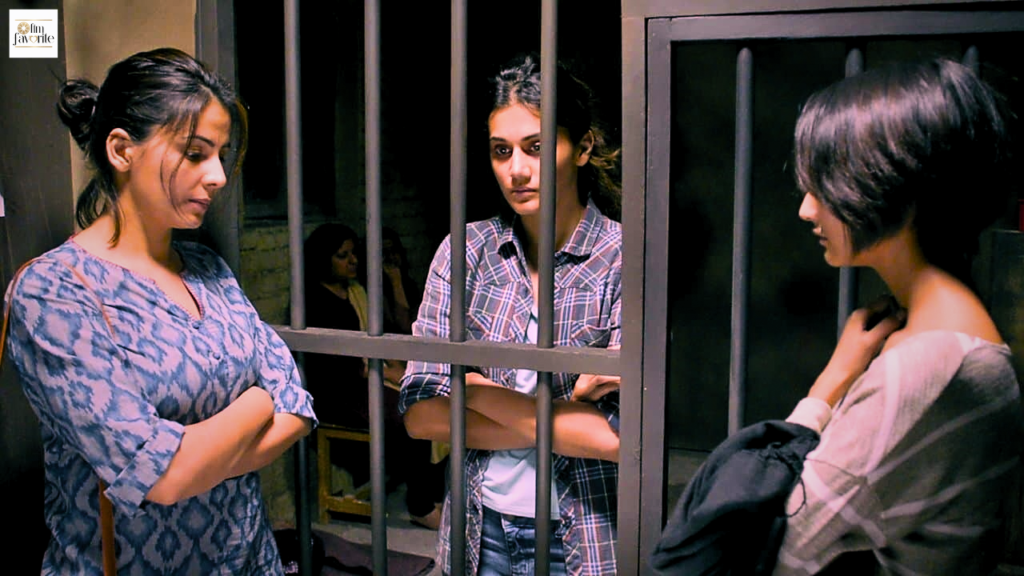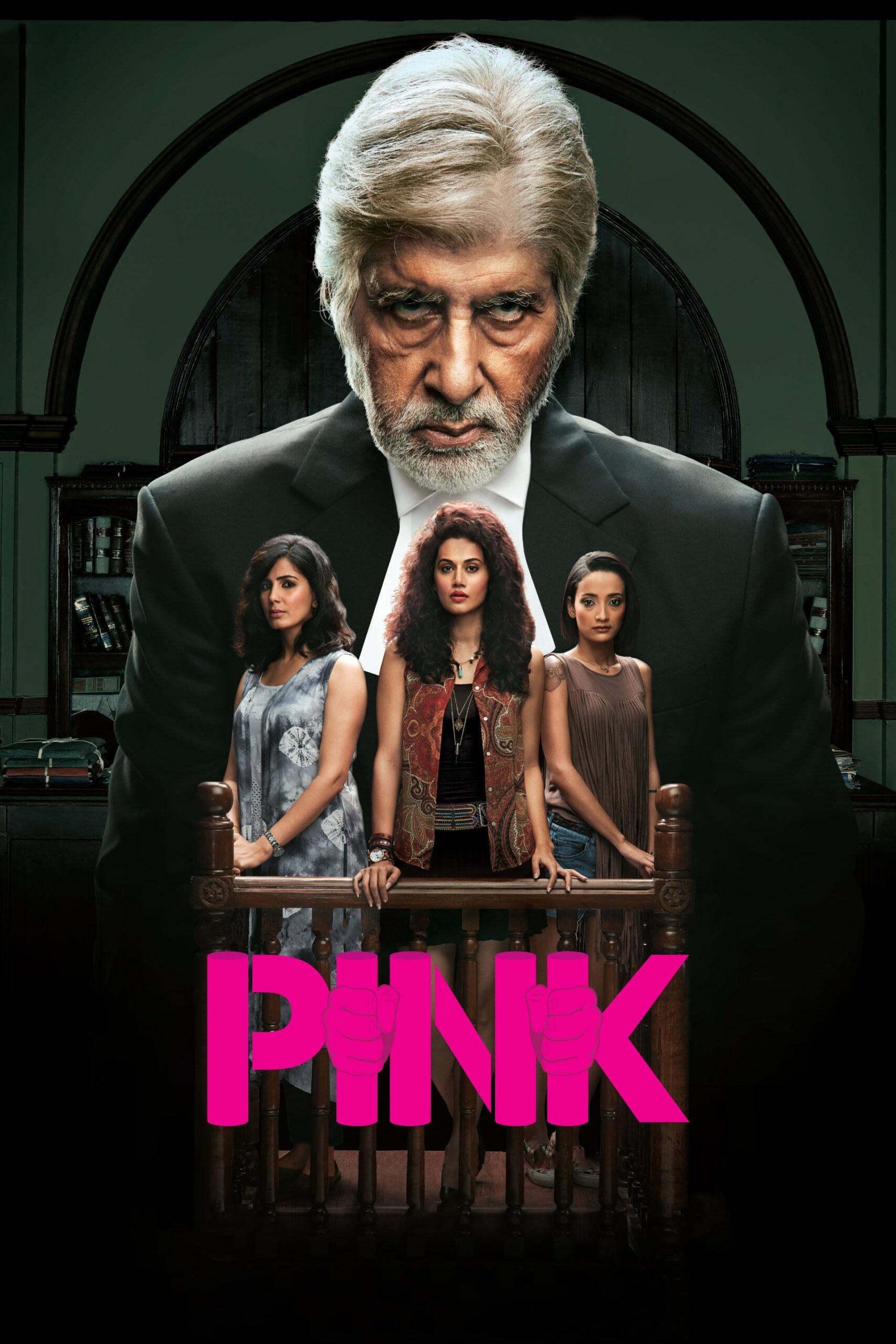Overview
A sexual assault victim, unjustly tried for the attempted murder of her attacker, is defended by a retired lawyer who challenges India's rape culture.
Synopsis
“Pink” is a powerful statement on the existing feudal mindset of a majority of India, where men and women are judged by a different yardstick. The story revolves around three Delhi girls – Minal (Taapsee Pannu), Falak (Kirti Kulhari), and Andrea (Andrea Tariang) – who find themselves embroiled in a legal battle after one of them escapes a molestation attempt by a powerful, pig-headed man, Rajveer (Angad Bedi). Minal attacks Rajveer with a bottle, injuring him grievously, setting off a chain of events that lead to their lives being turned upside down.
Story
The film begins with Minal, Falak, and Andrea enjoying a night out in Delhi, attending a rock concert. They accept an invitation from Rajveer and his friends to a resort in Surajkund for dinner and drinks. The evening takes an ugly turn when Andrea is touched inappropriately by Dumpy (Raashul Tandon) and Rajveer tries to force himself onto Minal. In self-defense, Minal strikes Rajveer with a bottle, injuring his eye. The girls return home, hoping to put the incident behind them.
However, their nightmare is just beginning. Rajveer, using his influential connections, files a false FIR against the girls, labeling them as prostitutes and accusing them of attempted murder. The matter escalates to court, where the girls are defended by the enigmatic lawyer Deepak Sehgall (Amitabh Bachchan), who suffers from bipolar disorder. The courtroom drama that unfolds exposes the deep-seated biases and double standards of society, challenging the very notions of morality and justice.
Review
Performances
Amitabh Bachchan’s portrayal of Deepak Sehgall is a standout, as he questions the societal norms and biases that seek to undermine the women he is defending. His dialogues are sharp, poignant, and resonant, laying bare the hypocrisy of a society that judges women harshly while often excusing the behavior of powerful men.
Bachchan’s character is complex and multifaceted. Despite his bipolar disorder, Sehgall brings a sharp intellect and relentless pursuit of justice to the courtroom. Bachchan’s performance is marked by his intense screen presence and the conviction with which he delivers his lines, making every courtroom scene gripping and thought-provoking.
The performances of Taapsee Pannu, Kirti Kulhari, and Andrea Tariang are commendable. They bring authenticity and depth to their roles, portraying the fear, frustration, and resilience of their characters convincingly. Taapsee Pannu, in particular, shines as Minal, showcasing a range of emotions from vulnerability to fierce determination. Kirti Kulhari and Andrea Tariang complement her performance with their nuanced portrayals of Falak and Andrea, respectively.
Angad Bedi as Rajveer and Piyush Mishra as the opposing lawyer also deliver strong performances, embodying the antagonistic forces that the protagonists must overcome. Bedi’s portrayal of Rajveer is chilling, capturing the entitlement and arrogance of a man used to getting his way, while Mishra brings a formidable presence to the courtroom, providing a stark contrast to Bachchan’s Sehgall.
Direction and Cinematography
Director Aniruddha Roy Chowdhury, along with producer Shoojit Sircar, has crafted a film that is both engaging and socially relevant. The direction ensures that the narrative remains focused on the core issues without becoming overly preachy. Chowdhury’s handling of the sensitive subject matter is commendable, striking a balance between drama and realism.
The courtroom scenes, inspired by Jonathan Kaplan’s “The Accused” (1988), are particularly well-executed, laying bare the societal biases that the film seeks to address. The tension in these scenes is palpable, with the stakes continually rising as the case unfolds. Chowdhury’s direction keeps the audience on the edge of their seats, while also provoking critical reflection on the issues at hand.
The cinematography by Abhik Mukhopadhyay complements the film’s tone, capturing the bleakness of the girls’ situation and the stark contrast between their world and that of their oppressors. The use of lighting and camera angles enhances the emotional intensity of the film, drawing the audience into the protagonists’ plight. Mukhopadhyay’s work adds a layer of visual storytelling that deepens the impact of the narrative.

Script and Dialogues
While “Pink” is strong in its thematic presentation, the script does have some shortcomings. The resolution of the case in the film relies more on emotional intelligence than on concrete legal evidence, which might seem convenient. This approach, while impactful, might not resonate with those expecting a more rigorous legal procedure. The script sometimes sacrifices realism for dramatic effect, which can undermine the film’s credibility.
However, the dialogues, particularly those written for Bachchan, are sharp and resonant. The film’s ability to articulate the fears and insecurities of modern Indian women facing daily harassment is one of its strongest aspects. Bachchan’s lines are memorable, often echoing long after the film ends. His courtroom monologues, in particular, are powerful, addressing the core issues of consent and gender equality with clarity and force.
The dialogue writing extends beyond Bachchan’s character. The lines given to Taapsee Pannu, Kirti Kulhari, and Andrea Tariang are equally impactful, capturing the raw emotions of their characters. The film’s script succeeds in humanizing these women, presenting them as multidimensional individuals rather than mere victims.
Personal Opinion
“Pink” is a film that left a lasting impact on me. It is rare to see a mainstream Bollywood film tackle such a relevant and sensitive issue with the depth and seriousness it deserves. The performances, particularly by Amitabh Bachchan and Taapsee Pannu, are outstanding and elevate the film. The courtroom drama is engaging and thought-provoking, making the audience reflect on their own biases and societal attitudes.
The film’s portrayal of the struggles faced by modern Indian women is both heart-wrenching and inspiring. It serves as a powerful reminder of the importance of consent and the need for societal change. While “Pink” may have its cinematic flaws, its heart is in the right place, and it succeeds in making a bold statement against gender inequality and the exploitation of women.
Watching “Pink” was a thought-provoking experience that made me reconsider my own perspectives on the issues it addresses. The film’s ability to provoke such introspection is a testament to its power and relevance. It is a significant film that should be seen by a wide audience, both for its message and its cinematic quality.
What’s Good
- Performances: Amitabh Bachchan delivers a stellar performance as Deepak Sehgall, with his powerful dialogues and intense screen presence. Taapsee Pannu, Kirti Kulhari, and Andrea Tariang also give commendable performances, bringing authenticity and depth to their characters.
- Themes: The film addresses critical issues of gender inequality, consent, and societal double standards, making it a relevant and important cinematic work. Its exploration of these themes is both bold and necessary, providing a mirror to societal attitudes that need to change.
- Direction: Aniruddha Roy Chowdhury’s direction keeps the narrative focused and engaging, ensuring that the film’s message is conveyed effectively. His handling of the courtroom drama is particularly noteworthy, maintaining tension and engagement throughout.
- Dialogues: The dialogues, particularly those delivered by Bachchan, are sharp, poignant, and thought-provoking, adding to the film’s impact. The script’s ability to capture the nuances of the characters’ emotions and the gravity of the issues they face is commendable.
What’s Bad
- Script Issues: The resolution of the case relies more on emotional intelligence than concrete legal evidence, which might seem convenient and unrealistic in a real courtroom setting. This narrative choice, while effective for dramatic purposes, may detract from the film’s realism.
- Pacing: At times, the film’s pacing slows down, especially in the non-courtroom scenes, which might test the patience of some viewers. The balance between drama and exposition is not always maintained, leading to occasional lulls in the narrative.
Rating
“Pink” is a film that is both important and impactful, despite its minor flaws. It stands out for its bold thematic content, strong performances, and thought-provoking dialogues. It is a must-watch for anyone interested in socially relevant cinema that challenges societal norms and advocates for gender equality.




1 thought on “Pink Movie Review (2016): Unmasking Social Hypocrisy”